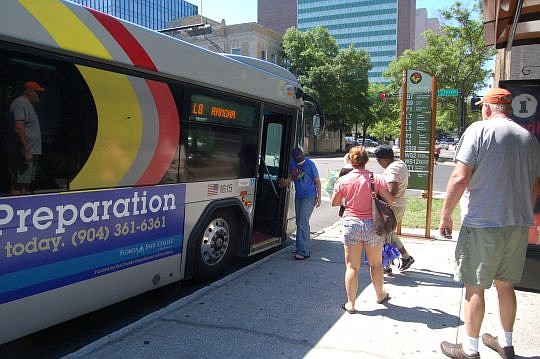
Beginning this morning, customers who use Jacksonville Transportation Authority mass transit services are getting a look at proposed bus routes scheduled to begin Nov. 24.
The “Route Optimization Initiative” is the first redesign of Jacksonville’s public transportation in more than 30 years.
“Almost everything will experience some type of change,” said Carl Weckenmann, senior manager of system planning.
JTA representatives will make information about the changes available to the public through Thursday at Rosa Parks, Gateway Town Center and Regency Square Mall transit hubs, he said.
The changes are based on customer feedback and an analysis of the system as it compares to other public transportation operations, said Brad Thoburn, JTA’s vice president of long-range planning and system development.
With more than 800 square miles of territory to cover in Duval County and no symmetrical grid outside Downtown, most of the 34 fixed routes that travel a total of 1,105 miles in the system are “circuitous.” that can make it difficult to plan routes that can maintain a dependable schedule, he said.
Redesigning the system should make it easier for more people to choose to use mass transit.
“We think a lot of folks would ride if it were more convenient,” Thoburn said.
One of the most sweeping changes is making more buses arrive at stops more often. Thoburn said there are just three routes in the system that arrive at a given stop every 30 minutes. The new plan would allow 30-minute frequency at 22 routes.
Weckenmann said subtle changes made over the past 30 years have led to adding stops to routes.
He said the main reason stops were added was to reduce the distance customers had to walk to a bus stop.
But more stops means a route takes longer to complete, which increases the time between buses and makes arrival times less accurate.
According to a survey of 1,609 riders conducted in 2013, only 54.8 percent of customers were satisfied or very satisfied with JTA’s on-time performance.
“Many of our routes meander through neighborhoods. Some buses stop every block or two blocks,” said Thoburn. “Riders are deterred if their trip takes too long or it isn’t reliable.”
Another change slated to take effect in November is system-wide implementation of a real-time information service that can provide the time of arrival of the next bus to passengers at any stop on the route.
The system has been in a trial on two routes in Arlington and may be accessed on the Internet, via a smartphone app or by calling (904) 242-6490.
Thoburn said the up-to-the-minute schedule information service will be expanded in November and bus stop signage will be improved to make the service more widely known.
The “On Time Transit Operations” system has been tested for six months on six routes that represent 35 percent of JTA’s weekday ridership.
The route schedules were modified to make the buses more reliable in terms of arrival times and additional buses were added to certain routes during peak ridership periods.
Thoburn said the system will be expanded in November when the new routes take effect.
JTA has already posted the new routes on its website, jtafla.com. Weckenmann said a series of public meetings and public hearings will be scheduled.
Changes could be made to the route plan based on customer reaction and input.
Public meetings are scheduled at 6 p.m.:
• Thursday at City Hall in Jacksonville Beach
•?May 29 at 2054 Plainfield Ave. in Orange Park
• June 5 at 5130 Soutel Drive
•?June 19 at 3939 Roosevelt Blvd.
“We are still in the planning stages. The public will have an opportunity to have their voice heard,” Weckenmann said.
Nathaniel Ford, the authority’s CEO, also said customer feedback about the proposed route changes will be considered before the routes and schedules are finalized and go into effect.
“We don’t want to do this in a vacuum,” said Ford. “We need customer feedback.”
(904) 356-2466